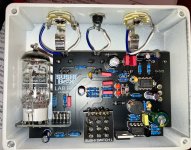joelorigo
Well-known member
My Lab Rat is sounding gated as a note fades or is gently plucked on the LED clipping selection. It does not do it on the 1N4148 selection. Picking hard it seems normal. It did not do this previously. I don't see anything jumping out at me looking at the guts. Anyone have any suggestions on what the issue is?
Attachments
Last edited:

